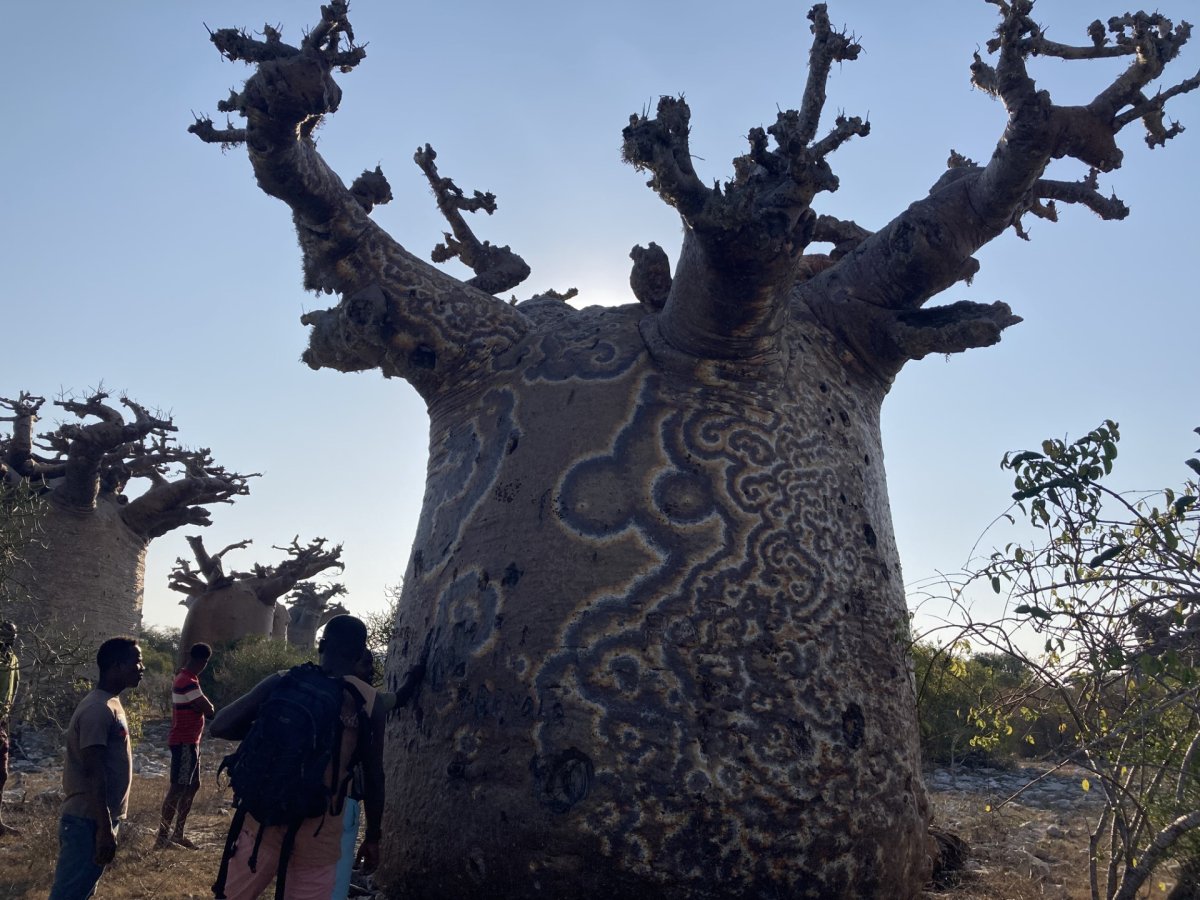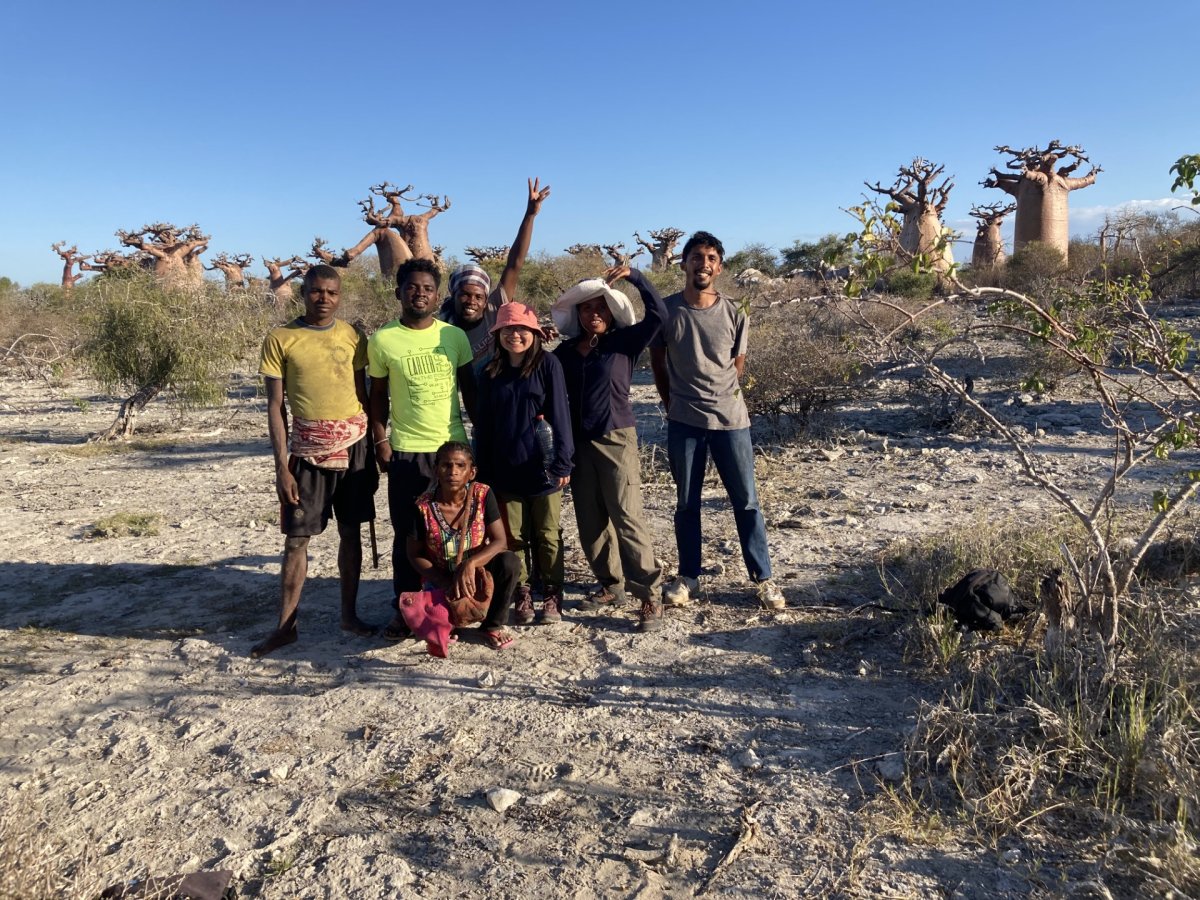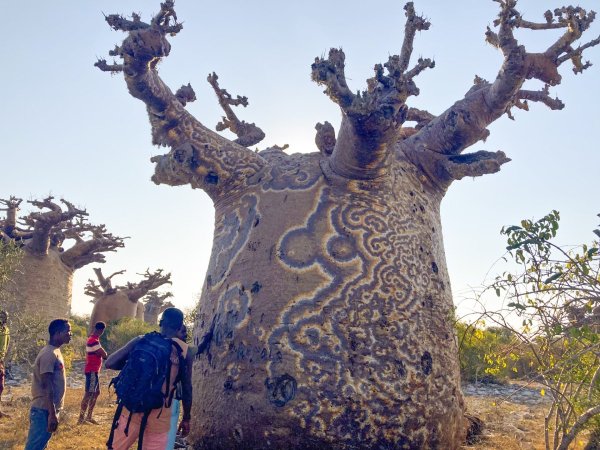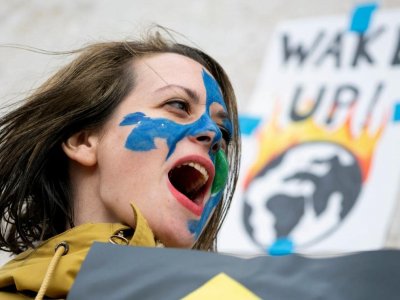In Southwest Madagascar, the sun shines brightly year-round. Thankfully, it rained the previous night, so the ground and air are a bit cooler than it has been for the past few days. I glance at my watch and, after measuring a few more trees for a research project, I clap my hands together and loudly announce:
Izay ty androany! [That’s all for today!]
The Malagasy research team accompanying me laughs (in a good way) at my Malagasy as we head back to our vehicle. I knew that English would not be commonly spoken in Madagascar, so before my trip, I spent months studying Malagasy, focusing on the Vezo dialect spoken in the coastal Southwest of Madagascar. Although my Malagasy was still at a rudimentary level, I knew enough to amuse my teammates and to make the occasional language pun.
***
In the summer of 2023, I spent a month and a half in Madagascar, where I conducted ecological surveys of baobab trees alongside a team of Malagasy scientists from the University of Antananarivo, Madagascar, and local community members from Andavadoaka fokontany (English: village), Madagascar. Luckily for us, the wondrous baobab trees that we were surveying towered over other vegetation in the landscape and were easily visible from kilometers away. Unsurprisingly, these trees, which can grow large enough in diameter for humans to live inside, draw in a considerable number of foreign tourists. However, they also serve a more important function to local communities by providing resources: their large trunks and wood provide shelter and tools, their fruit and seeds provide nourishment, and their leaves can be used to quickly fatten up livestock. Baobabs can also be sites for cultural and ancestral practices for some communities.

In Madagascar, there are seven species of baobabs, six of which are endemic, meaning that these species are not found outside of the island. Unfortunately, in the Southwest, where three baobab species occur, a fungal disease threatens the health of these trees. Diseased trees have breathtaking orange-yellow swirly patterns on the bark that look like they’ve been painted on. Researchers do not know much about how the fungus operates, including how quickly it spreads, how many trees in the Southwest are infected, and how long it takes between infection and death.
When I first arrived in Madagascar, I had a plan in mind – my goal was to collect tree cores from baobabs so I could determine their ages and compare these ages to archaeological materials in the area. If the ages of baobab trees and archaeological site occupations were similar, it could suggest that past human communities helped disperse baobabs (for example, by planting) – and thus, that future communities play a key role in maintaining healthy baobab populations.

However, after a meeting with the Morombe Archaeological Project (MAP) Team, which is primarily composed of local community members, I found that they were more interested in answering a different question: Why are our baobab trees dying, and what can we do to save them? After the conversation, I pivoted to collect additional data relating to fungal disease while collecting tree cores for my originally planned project. For example, my team and I recorded the degree to which different baobabs in the area were infected as well as how much bark had been stripped from each tree by humans; these data were collected to test a hypothesis suggested to us by the president of Andavadoaka fokontany that stripping bark from a baobab might make the tree more susceptible to future fungal disease.
Keeping lines of communication open between the research team and other communities that we visited was essential to the success of our project. At every site where our team collected data, we first visited the president of the nearest fokontany to explain the project and gain the consent of the community. This was much appreciated; for example, the president of Ambalorao fokontany told us that in the past, there were baobab researchers who collected data and marked some nearby trees with orange paint, but they didn’t tell the community what they were doing. After collecting their data, the researchers never came back either to communicate the results. Years later, the president still wondered what work had been done in their community.
Additionally, at each of our sites, we recruited a member from the nearest community to accompany us during our data collection. The presence of this community liaison not only ensured that our research was more transparent to nearby communities but also improved the quality of the data we collected and expressed respect to the communities and places we visited. For instance, a leader in a Mikea community taught us the local names for different plants, which allowed us to record the floral diversity surrounding each baobab. He also initiated a fomba (English: tradition) to ask permission from ancestors to bless us prior to our data collection. The fomba was crucial to show respect to the forest and the nearby Mikea community, but without the Mikea leader's participation in our research team, we could not have known about the deep respect the community has for its forest.

For many graduate students who recognize the need to include local communities in every aspect of their research, knowing where to start can be daunting. In my case, I was very fortunate that much of the infrastructure, such as the MAP Team, already existed, which helped me connect with nearby communities and overcome the language barrier. Even with that infrastructure in place, I still spent years forming authentic connections with some of the people I’d be working with before stepping foot on the island. It turns out that there is no shortcut to success when forming connections and working with human beings.
I’m eternally grateful to the community members I’ve interacted with who have welcomed me with open arms, as well as to my advisor, Dr. Sarah Ivory, who recognized that it takes time to form genuine relationships and allowed me to take that time during my Ph.D. I am already looking forward to my next time in Andavadoaka fokontany, to fulfill my promise to Felicia Fenomanana, a new friend and collaborator: Mbo himpoly aho. [I’ll be back.]

Acknowledgements and Disclaimer: Special thanks to my good friends and colleagues, Fai Chanchai (Penn State University, Dept of Geosciences) and Clara Randimbiarimanana (University of Arizona, Dept of Anthropology) for their comments on a previous draft of this blog post. This material is based upon work supported by the National Science Foundation Graduate Research Fellowship Program under Grant No. DGE1255832. Any opinions, findings, and conclusions or recommendations expressed in this material are those of the author and do not necessarily reflect the views of the National Science Foundation.
Karen Pham is a geosciences doctoral candidate and an NSF Graduate Research Fellow. Her research attempts to untangle the drivers of spatial distributions and trait evolution in plants, with an emphasis on ecosystems in Madagascar. She is also particularly interested in examining how the institution of science can be made more just; as a part of this interest, she advocates for knowledge co-production with local place-based communities.





